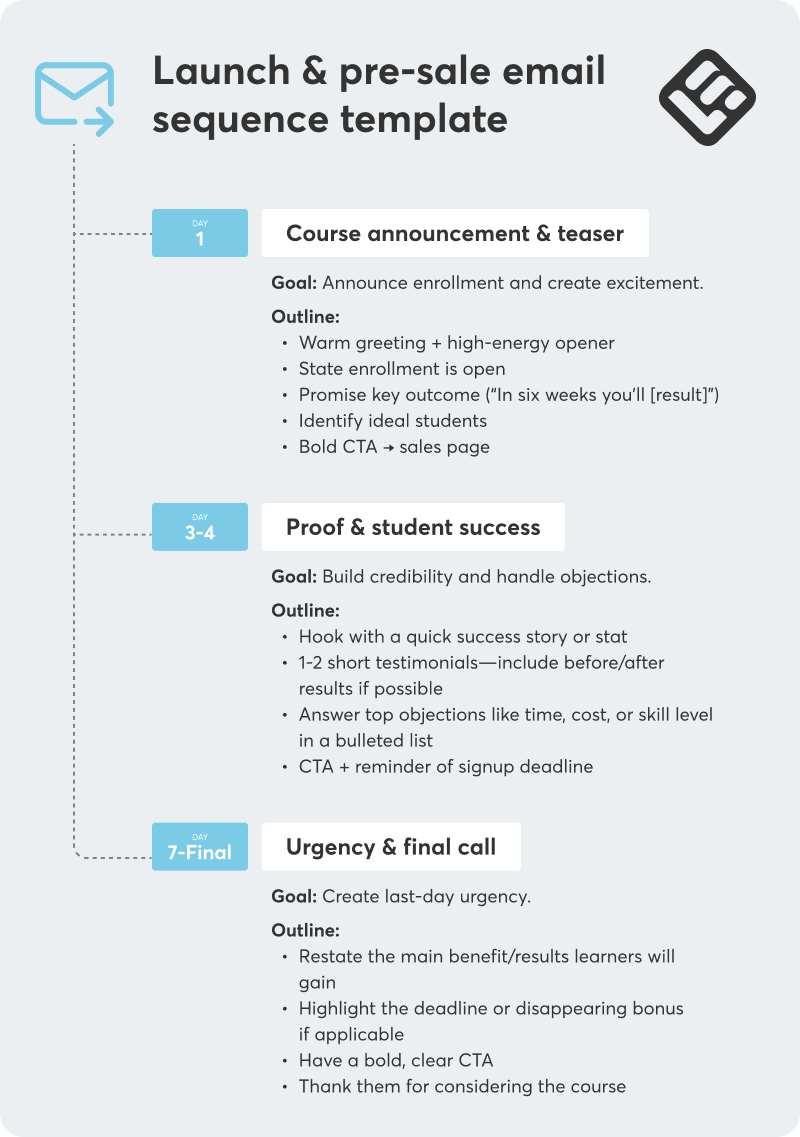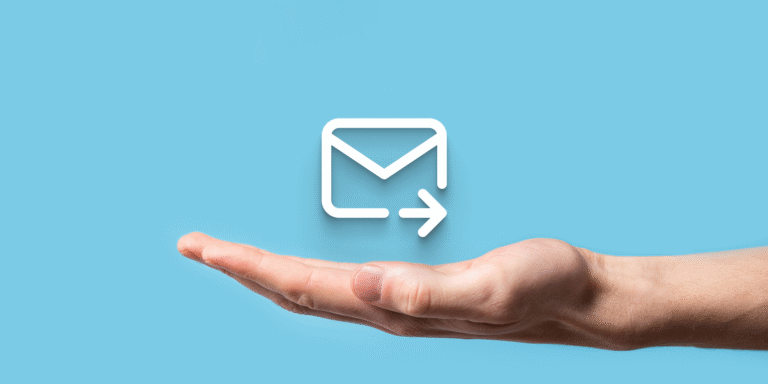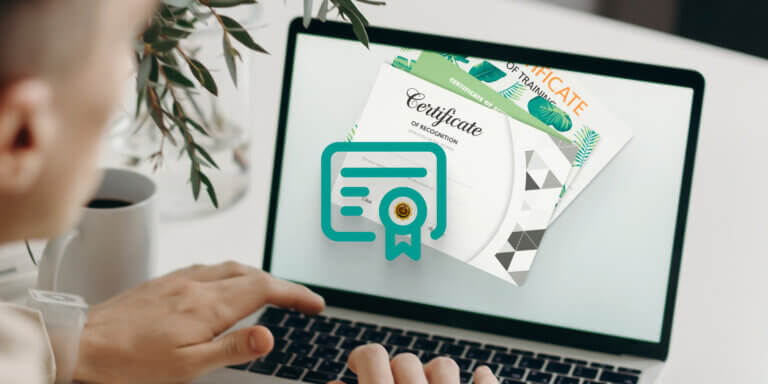Table of Contents
If you’ve built a course and it’s just not selling, it might not be your content that’s to blame. Often, it’s because you don’t have the right marketing plan in place. With an email strategy to sell online courses, you can help turn sales around.
To help you out, I’ve put together a guide on email marketing that covers everything from growing your list to automated email sequences for courses.
I’ve also checked the data—did you know that email has an average ROI of 3,800% [1]?—and reached out to a real course creator for insight to see what the experts are saying about using email marketing for online courses.
Oh, before you dive in: this article might feel a bit jargon-heavy. To help, I’ve made a master glossary of all the terms I cover. You can find it at the end of the article in the FAQ section.
Why email still sells courses
Social media platforms change their rules, and feeds get noisy. But email is the one channel you totally own and control. And though marketing teams juggle an average of eight different tools, email remains the primary channel for direct conversions.
Because when you send an email, it shows up in a place—the inbox—where people tend to be active rather than passive. Instead of scrolling, scrolling, scrolling, looking for the next best thing, people open their inboxes with a decisive mindset.
Here’s the simple logic behind it. I mapped to the classic AIDA (Awareness, Interest, Desire, Action) journey so you can see how your sequences can drive sales:
When you have a well-made email strategy to sell online courses, you show up in the right order, at the right moment, with the right message. Then a curious subscriber becomes a paid student.
Build and segment your list
Let’s start at the beginning. Whether you’re selling courses as part of your side hustle or for your main gig, you need to set your foundation for your email marketing strategy. It’s going to start with a tight lead magnet funnel and develop into segmentation, where you make sure your readers will be sent emails that actually apply to them.
We’re going to round this off by making sure everything is compliant, so your emails actually get where you want them to go. And the finishing touches will set you in the right direction to grow, using tools and strategic calls-to-action (CTAs) that get readers to click.
This process is important because it supports how all of your email marketing efforts will manifest. Without it, you risk having a disorganized and impersonal email sequence with more people clicking “unsubscribe” than “sign me up”.
💡Check this workshop by Jeanne Jennings to learn how to grow your own email list.
Launch a lead magnet that matches your course outcome
This is entry ticket #1. Interested people will give you their email in exchange for something that they think they’ll find helpful, aka the lead magnet. This is often a free resource or tool.
Lead magnets can be a whole slew of things, but ones I see a lot include:
So how do you get these offers in front of people? Share them at places your audience already goes and interacts with. I see them at the bottom of LinkedIn posts, on company landing pages, or even in social media bios.
Make it easy for people to leave an email and get the lead magnet right away. These are the spots that usually perform best:
Keep these friendly and fast: one field (email) and a clear button like “Send me the template.” For phones, try to avoid full-screen pop-ups, show each prompt at most once per visit, and make sure they are hideable after someone signs up. No one wants to feel haunted.
Skyrocket your online school’s enrollment with these 59 email marketing tips and tricks.
Segment with simple, useful tags
This is something I didn’t really know about when I set up my email list for my blog. And, I wish I had. Using tags to segment your subscribers into categories helps you stay organized as you grow and makes sure that they get the content that matches them best.
You do this in your email tool—ConvertKit (now simply “Kit”), MailerLite, MailChimp—or through your learning management system (LMS) if it supports email marketing.
There are lots of tag types, and you can really make up any tags that you see fit, but I suggest just starting with two:
It can be tempting not to do this if you only have one platform and one lead magnet, but the goal is to grow, right? So don’t follow my example…get this foundational step locked in early so you stay relevant and organized.
Down the road, you can branch out to more extensive tags as they fit. Some examples are:
Amplify growth once the system works
When someone leaves their email to get your freebie, that’s an opt-in. If those opt-ins turn into clicks and sales, widen the top of the same funnel. Don’t change the offer, just send more of the right people to it.
Run simple lead ads on socials that point straight to the freebie. Add clear calls to action where people already look, like in your site header or footer, bio links, and YouTube descriptions or pinned comments. Be specific with the ask—“Get the worksheet” beats “Subscribe.”
Make it trackable by giving each channel its own link or page—a tiny ?source= tag is enough—and save that source in your email tool. Once a week, scan the path: source → opens → clicks → sales. If LinkedIn sends buyers and Facebook doesn’t, for example, shift your time and budget accordingly.
Core sequences for marketing online courses
This is where email campaign ideas for online course creators start working like a system. A good sequence takes someone from “just downloaded the freebie” to “I’m ready to enroll,” one small step at a time.
I’ve got a set structure for you to follow for your email sequences, which I’ll outline in the next few sections. While you don’t have to follow if you don’t want to, I highly recommend doing so.
This structure helps you:
Lead-magnet delivery (day 0)
This is a short email your readers get quickly (ideally within minutes) after signing up for your lead magnet. It says thanks, reminds them what they asked for, and gives it to them. In this email, you’re also going to take care of a little housekeeping to make sure future emails will be well-received.
Here are my tips to make it a success:
To encourage engagement, you can also invite the reader to respond directly to the email with their thoughts. And always ask the reader to whitelist your email so future sends don’t wind up in their spam.
Indoctrination / welcome series (days 1–5)
This series of emails helps new subscribers get to know you and get a quick win before any course-related pitches. It builds trust, so your later offer doesn’t feel out of nowhere. What you send will depend on your niche and course, but here are some ideas.
Day 1: Share a quick win, one tiny tactic that builds on the freebie. One idea, one action, one link.
The subject line could look like: “A 90-second fix you can use today”
Day 3: Share your story to build your credibility and let readers know why you teach this. This is the perfect email to include a proof point, like a real student outcome or testimonial.
Try using a subject line like: “How I learned this the hard way, and why it inspired me to teach”
Day 5: Here you want to get the conversation going. Ask your reader a simple question to learn about their roadblocks, and invite them to reply to you directly. This can help you figure out what their needs are and tag them under those, so you can make sure they get relevant emails in the future.
This can be a really simple subject line like: “[Name], what’s blocking you right now?”
This sequence is a huge part of your overall email strategy to sell online courses, as it sets the tone for future emails to come and invites interaction and trust.
Launch / course pre-sale sequence flow
Now you want to move towards sales. Consider this your open-cart sequence. Its job is to turn warm subscribers into buyers with clear info, proof, answers, and a deadline.
Ideally, this course pre-sale sequence will take place over seven days, or seven emails if you aren’t sending very frequently. I don’t suggest sending one email every day, as that can be overwhelming and might frustrate readers.
Here’s a sample of what your schedule could look like:
I get that you might want some more insight into what these emails might look like in practice. So here’s a screenshot of one I received recently.

I got this email from LearnWorlds, gently reminding me to sign up for their live virtual summit. You’ll notice that’s not all it says—it also includes a summary of what I can expect to learn, creates urgency and scarcity (it only happens once a year), and has a very prominent “Register now” button.
And before you move to the next section, here’s a template you can take away that includes outlines for a three-day example sequence for this stage.

BOFU branch for fast action and objection handling
BOFU is just short for “bottom of the funnel”, or the decision stage for people who’ve shown intent to buy but haven’t purchased yet. If the lead-magnet delivery email is TOFU, or top of the funnel, then the cart-close/last-chance email is BOFU.
In this email sequence, you want to capture the attention of people on the fence. The sequence triggers when someone clicks your sales page but doesn’t buy, and its job is to find the block, answer it, and give the reader a simple next step.
Here’s what a short, not-pushy, 3-email BOFU sequence schedule could look like:
Email 1: Send this the same day they visited your sales page, and invite a reply—“Anything holding you back?”—plus a tiny proof snippet.
Subject: “Still deciding?”
Email 2: Send this 48 hours later and try to address the top possible reasons for not buying, the “objections”. This could be price, how long it takes to complete the results, or that the potential buyer isn’t convinced they’ll get results. Address these objections by inviting them to watch a quick pre-recorded Loom or a complementary Q&A session with you.
Subject: “A quick answer to the #1 question”
Email 3: Send this to align with the deadline to sign up for your course. Keep it respectful, and use it to nudge them towards signing up before the cutoff time. I recommend sharing a testimonial or review from a previous student here to address any lingering objections.
Subject: “Heads up: the deadline for [course name] is close”
Downsell and win-back
Sometimes people don’t buy. That’s ok, a 100% success rate would be pretty cool, but it almost never happens. To funnel those individuals back in, you’ll use a downsell and win-back emails approach.
The aim is to offer a smaller step or rekindle interest without pressure.
Here’s one example of each type of email.
Downsell:
Subject: Prefer a lighter option?
Hi [First name], if the full course feels like too big a step right now, try the 90-minute [workshop name]. It shows you how to [specific outcome] and comes with a short practice exercise.
It’s ideal if you want momentum this week. But if you’re ready for the full roadmap, the main course is still the better fit. Join here → [link]
Win-back:
Subject: Your free lesson is ready
Hi [First name], we haven’t chatted in a while. I made a 5-minute lesson on [topic] that you can use today to [quick win]. Watch it here → [link].
No pitch—just something useful. If it helps, hit reply and tell me what you’re working on next. I’d love to hear from you.
You can see in the Downsell email how the focus is to give the reader something smaller to tackle if the full course felt like too much, while the Win-back is there to pull readers back in who may have stopped opening or interacting with your emails altogether.
If these subscribers stop interacting with your emails after these sequences, though, it might be time to cut them loose and remove them from your subscriber list.
Post-purchase success and upsell
Even when—actually, especially when—someone has signed up or bought your course, you want to make sure you keep the momentum going. These email sequences are to turn buyers into successful students and repeat customers.
When done well, they can also reduce the number of course refunds due to unhappy students and give your signups the next logical step to take after they purchase your course.
Email 1 (immediately): warm welcome + first steps
Subject: “Welcome—here’s how to start strong”
Here’s where you say thanks for signing up and point them straight to their first small win. Put the login link right up top so it’s easy to find, then nudge them into motion with some clear steps like starting Lesson 1 or joining your online community.
Close the email with how to get help if they need it and a quick note about what’s coming next in a few days.
Email 2 (day 3–4): quick wins, common pitfalls, and help
Subject: “Do these first 3 things”
Share a tiny checklist that can direct them through the course so they don’t lose momentum. Call out one or two easy-to-make mistakes and give the fix. If you’ve got it, link a 60–90 second screen recording that shows the trick. Remind them where to ask for help so they never feel stuck.
Email 3 (day 7–10): check-in + one-click survey
Subject: “How’s it going? Tell me in one click”
Ask how it’s going with a tiny poll: “I started / I’m stuck / I finished the first module”. End by inviting a one-line reply on their biggest blocker so you can point them to the best next step. This tells you the right next email to send them.
If they’re moving forward well in the course, the next email will offer the next logical step—an advanced course, coaching, or a bonus training—framed as “when you’re ready,” not a hard pitch. If they’re stuck, send them to the right rescue, like a troubleshooting guide or a quick win lesson.
“Best-of” evergreen newsletter
Evergreen marketing funnels are a core part of any type of email marketing. This keeps your list warm between launches and gives them thoughtful, helpful content to peruse.
We use our monthly newsletter to keep interested leads up to date on industry opportunities. Promoting promising, time-based opportunities from external entities entices many leads to take the leap. We don’t want leads to forget how much potential they have, or how much seizing the moment at the right time might revolutionize or secure their future.
Here’s an example of one I got recently from a list I’m subscribed to.

This didn’t even mention her paid offers, but instead focused on giving me helpful content and building our relationship.
Here’s how you can do that too:
Subjects could be something like: “Your monthly boost: [Details about specific content]”
In-email mini-lesson templates
Mini lessons are short teaching emails you send between promos to keep people moving. They show that you can help without simply pushing your full-blown course. They should be centered around one simple idea and be supported with a quick example of something the reader could start that day.
You can drop one into your welcome flow after the delivery email, or send one every week or two between launches.
Here’s an example of an email I received recently that fits this mini-lesson idea to a T.

In this email from The Wordling, the author gives me one small but very, very actionable lesson on how to calculate success rates for pitches. It relates to her email content in that it’s designed to help writers learn how to grow their businesses, but focuses on this mini-lesson rather than a larger, macro approach.
At the end of the lesson, she prompts me to check out her masterclass. It’s a gentle but effective way to show me that her content has value and to prime me for any future pitches she might have for paid content.
Automation and CRM setup
Automation is the system that sends the right email to the right person at the right time, so you can keep selling without manually hitting “send” every day. The biggest step here is picking your ESP, or email service provider.
There are tons of them to choose from, so I suggest signing up for free trials and taking advantage of live walk-throughs (MailChimp, for example, sets you up with an expert to walk you through a demo, and it’s great).
Here are some popular ESPs to check out:
As you test these out, check the details on paid vs free features. Sometimes free trials give you access to great features that become quite pricey once it’s time to pay. And make sure they are intuitive for you to use and support all of the aspects you want to include in your email marketing strategy.
As you set up your automations, follow these best practices.
1. Keep tagging simple
Tags are labels you attach to subscribers to track interests or actions.
For example:
Lead Magnet A + Interested in Design
Now you can send design-related offers only to people who care about them, instead of blasting everyone.
2. Set start/stop rules
Automation rules prevent messy overlaps. Add conditions like “exit if already in Product Launch sequence” so no subscriber ends up in two promos at once.
3. Follow deliverability basics
Getting into the inbox isn’t automatic. We covered some of this already, but as a reminder:
I know SPF sounds like it belongs to sunscreen, and DKIM and DMARC might sound like nothing to you, so here’s a handy table to set you on the right track.
Lastly, consider going plain text with your emails. This means writing them to look like a regular personal message—mostly text, minimal images or fancy formatting.
Text-first emails feel personal and often dodge the Promotions tab, which means more opens and clicks. A logo or single image is fine, just skip the heavy design.
High-ticket coaching example
We’ve covered a lot of ground so far here, so thanks for sticking with me. I think it’s time to take a step back and look at an example. Let’s see how what we’ve talked about could work for a high-ticket coaching offer.
Picture a $2,000 package and a coach who wants to sell it mostly through email.
Here’s one possible flow:
Free guide → nurture emails → VSL (video sales letter) → strategy call → close.
It starts with a free guide—maybe “5 mindset shifts to double your revenue”—that draws in the right audience. Over the next week, a handful of nurture emails land in their inbox with short wins and client stories. By email three, subscribers are invited to watch a VSL where the coach lays out her method and results.
Those who watch most of the video receive a prompt to book a strategy call, where the coach diagnoses goals and, if it’s a fit, presents the $2,000 offer.
Behind the scenes, simple tags keep the coach organized. For example, tagging anyone who watched 75% of the VSL but didn’t book, then sending a follow-up reminder or bonus offer.
This funnel is just one way to put all the email pieces we’ve been talking about into action. The details can shift to fit your audience or offer, but the idea stays the same.
Landing page optimization for courses: Elements to include
Ok, onto landing pages, the place where all those carefully nurtured emails send people when they’re ready to click. A polished landing page with learning outcomes listed clearly can be the difference between a curious visitor and a new student.
Here’s a mini checklist of what you should include on yours.
1. Headline with a clear result
Promise the outcome your course delivers, like “Go from zero to fluent in 8 weeks” or “Land your first freelance client in 30 days.” Make it immediate and specific.
2. Social proof that builds trust
Show that others have succeeded with you. Add testimonials, total student numbers, or “as seen in” logos.
💡For inspiration, check how Corporate Finance Institute highlights student success or how JobPrepped showcases press mentions.
3. Pricing clarity + risk-free guarantee
State the price up front and include a money-back or satisfaction guarantee to lower purchase anxiety.
4. Big, above-the-fold CTA button
Place a clear call-to-action button like “Enroll Now” high on the page so visitors don’t need to scroll. Repeat the CTA after every major section so it’s always within reach.
5. One primary CTA per page
Stick to a single action—enroll, sign up, or buy. Too many choices create friction and decision fatigue.
💡A page that checks these boxes keeps momentum from inbox to checkout and functions as a high-converting sales page for your course.
Best tools for course creators
The right tools keep your email marketing organized and scalable. Here’s a quick side-by-side to help you choose.
If you’re ready to go beyond the basics, advanced testing and analytics tools like Emarsys, Litmus, or Invesp can help you A/B test subject lines and fine-tune deliverability at a more professional level.
Pick one that matches your current stage, then upgrade as your course business grows.
Measurement, cadence, and continuous improvement
Everything we’ve covered up to this point is great, but it doesn’t mean as much if you don’t know how to measure the success of your efforts. Without understanding how to recognize key metrics and how they can help you improve, your email strategy might stagnate.
Focus on three things—measurement to see what’s working, cadence to keep a steady rhythm, and continuous improvement to refine each send.
Key metrics and healthy averages
These numbers are more industry averages to guide you, rather than hard and fast rules. That being said, here are some ranges to look for:
Your niche, list size, and content will all influence your actual results. Different studies even report slightly different ranges.
For example, Litmus cites 20-30 % average open rates and 3-5 % CTR, while Invesp notes that a “good” email conversion rate can range from 1% to 5% depending on industry and offer quality.
Use these as guideposts to track trends in your own data rather than strict targets.
The 70/30 value-to-sell ratio
Keep about 70% of emails focused on value—tips, stories, quick wins—and 30% on direct offers.
In a weekly email sequence, here’s an example rhythm:
Simple A/B tests
Start small and test one variable at a time so you know what really moves the needle. A few easy wins:
Pick one test, let it run until you have a meaningful sample (at least a few hundred opens if possible), and then apply the winner to your next send.
Staying compliant so emails land
GDPR (in the EU) and CAN-SPAM (in the US) are basic rules for emailing people: Say what they’ll get, say who you are, and let them unsubscribe if they want to without friction. Do that, and your messages are far more likely to show up in the inbox instead of spam.
You can skip the legal jargon and do this pretty easily by:
Here’s an example of how InHerSight uses its footer to keep emails compliant.

Attract paying students with your email marketing strategy
You now have everything you need to build an email engine that grows your list and sells your course again and again. There was a lot of info in this article, so don’t be afraid to bookmark it so you can reference it as you build your marketing strategy.
And if you’re ready to get started, give LearnWorlds a shot. LearnWorlds LMS combines course hosting with powerful email automation, so you can design your program and run your marketing in one place.
Sign up for a free trial and start your first sequence today so the next time you meet a future student, it’s in their inbox.
Sources
[1] Marketing ROI (Return on Investment): Definition and measurementKyriaki is the SEO Content Manager at LearnWorlds, where she writes and edits content about marketing and e-learning, helping course creators build, market, and sell successful online courses. With a degree in Career Guidance and a solid background in education management and career development, she combines strategic insight with a passion for lifelong learning. Outside of work, she enjoys expressing her creativity through music.

Ciera Lamb
Ciera is a freelance content writer and editor connecting companies with their ideal audiences through blog articles and other online content. She approaches her writing with curiosity and research and enjoys the ever-present learning that comes with being a content writer. She is also an avid scuba diver, an aspiring Dutch speaker, and lover of all things nature.
FAQ
Everything you have ever wondered, but were too afraid to ask...





